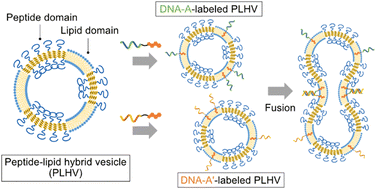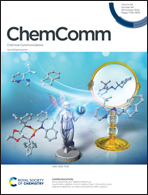DNA-induced fusion between lipid domains of peptide–lipid hybrid vesicles†
Abstract
Peptide–lipid hybrid vesicles were prepared with complementary DNA strands in their lipid domains. Hybridization of the complementary DNA strands induced the controlled fusion of the vesicles during repeated heating and cooling cycles. Vesicle fusion was indicated by a decrease in the efficiency of Förster resonance energy transfer between lipid-localized probes (from 72 to 42%) and transmission electron microscopy analysis. We suggest that this approach is a general strategy for the creation of polymersomes with membrane-fusion functionality.



 Please wait while we load your content...
Please wait while we load your content...